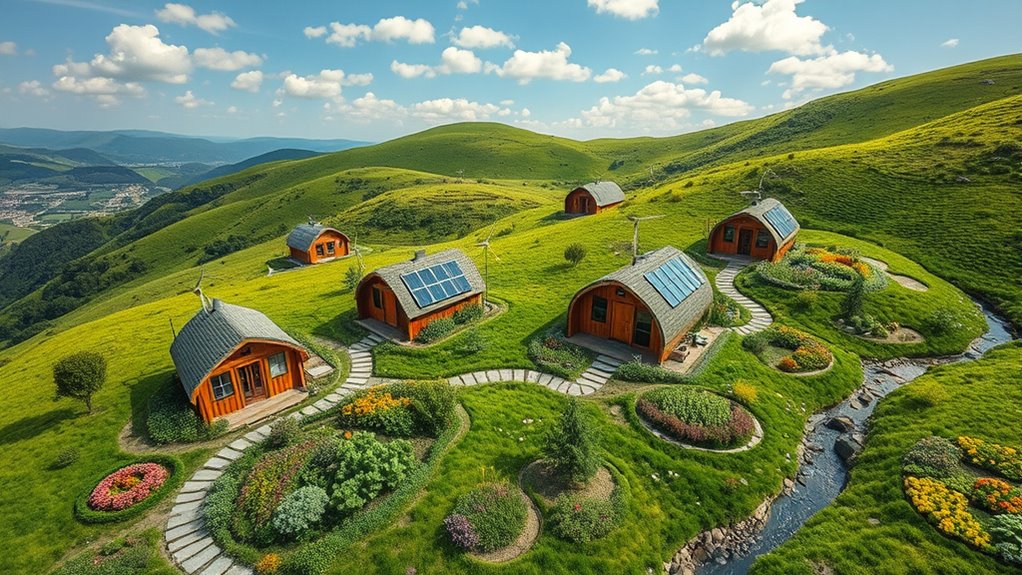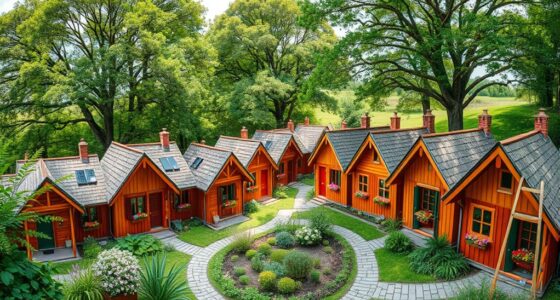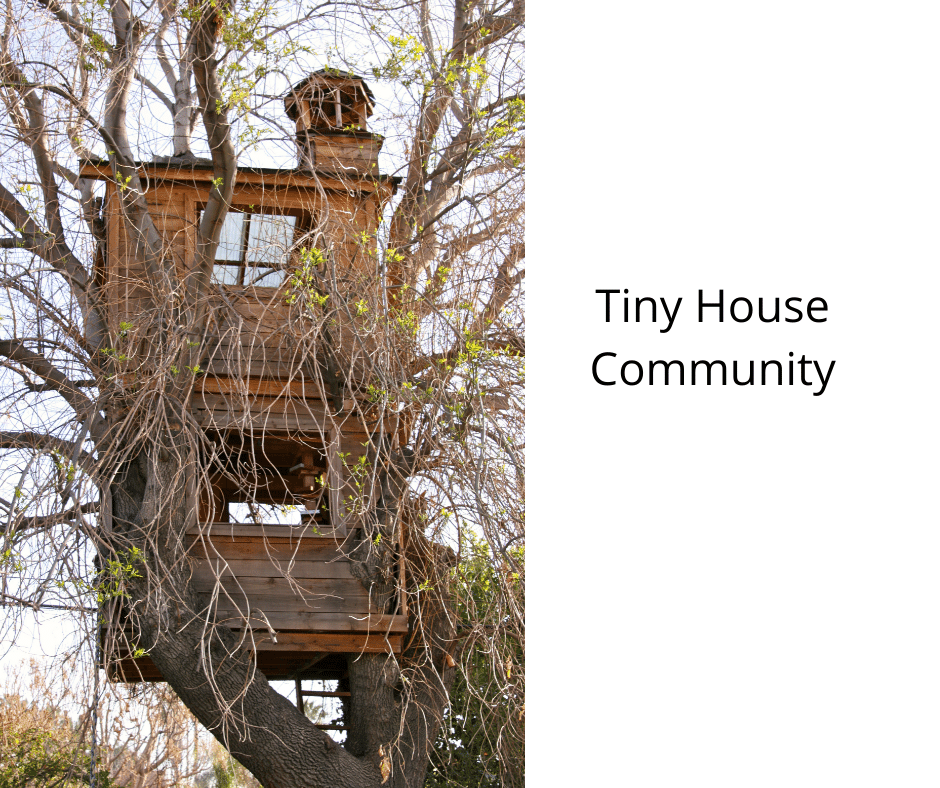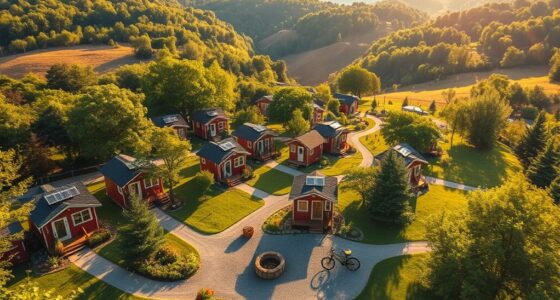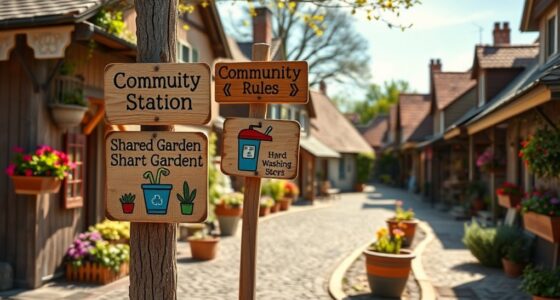Exploring eco-tiny communities around the world shows how small-scale living can be sustainable and innovative. These neighborhoods use eco-friendly materials, harness renewable energy, and promote resource conservation through features like solar panels, rainwater harvesting, and natural ventilation. They foster community efforts in composting, shared gardening, and eco-education, creating environmentally responsible lifestyles. If you keep exploring, you’ll discover inspiring ways these communities are transforming daily life while protecting the planet.
Key Takeaways
- Eco-tiny communities worldwide prioritize sustainable building materials like reclaimed wood and recycled metals to minimize environmental impact.
- They often integrate renewable energy sources such as solar panels and small wind turbines to promote energy independence.
- These communities utilize resource conservation methods like rainwater harvesting, greywater recycling, and natural ventilation.
- Collective projects like community gardens, composting, and eco-education foster collaboration and shared environmental goals.
- They demonstrate how small lifestyle changes and innovative design significantly reduce ecological footprints globally.
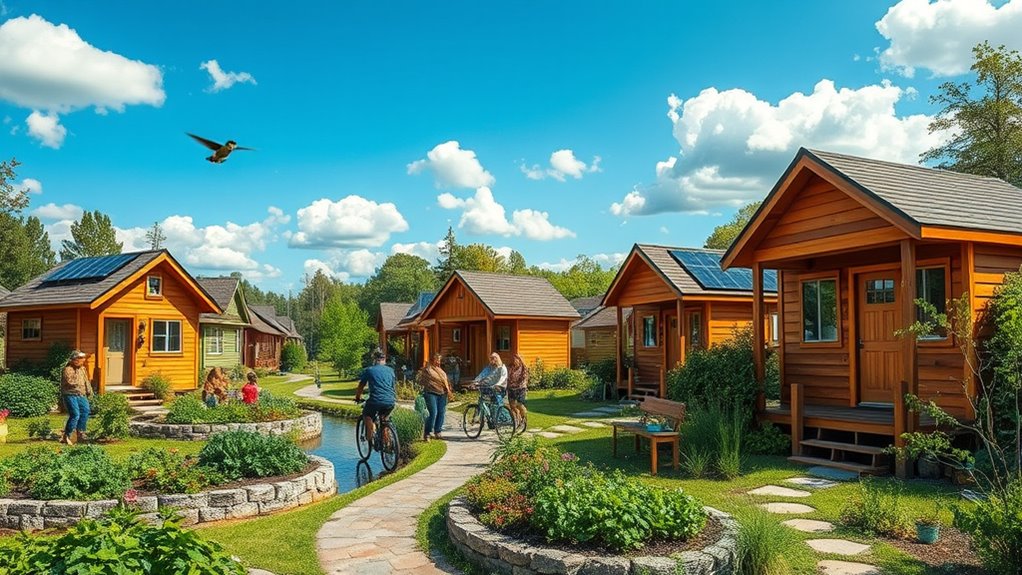
Across the globe, eco-tiny communities are gaining popularity as people seek sustainable living options that reduce environmental impact. You might find yourself drawn to these communities because they prioritize efficient use of space and resources. One of the key features that make eco-tiny communities stand out is their focus on sustainable building practices. Instead of relying on traditional, resource-intensive construction methods, these communities often use eco-friendly materials like reclaimed wood, bamboo, and recycled metals. The goal is to minimize waste and energy consumption during construction, creating homes that are not only beautiful but also environmentally responsible.
Eco-tiny communities use sustainable materials like reclaimed wood and bamboo to minimize waste and energy use.
As you explore eco-tiny communities, you’ll notice how vital renewable energy sources are to their sustainability. Solar panels are a common sight, harnessing sunlight to power homes and communal facilities, reducing dependence on fossil fuels. Some communities also incorporate small-scale wind turbines or micro-hydro systems where appropriate, making the most of local renewable resources. This emphasis on renewable energy helps residents lower their carbon footprint and promotes energy independence. It’s inspiring to see how these communities integrate clean energy solutions seamlessly into their daily lives.
Living in an eco-tiny community means embracing a lifestyle centered on conservation and resourcefulness. With smaller living spaces, you naturally use less energy and water, which contributes to overall sustainability. Many communities implement rainwater harvesting and greywater recycling systems to further reduce water waste. These innovations, combined with sustainable building designs that maximize natural light and ventilation, make the homes more energy-efficient and comfortable. You’ll find that residents often share gardening spaces or engage in community farming, which promotes local food production and reduces the environmental costs associated with transporting goods.
Participating in an eco-tiny community also means becoming part of a like-minded network committed to sustainability. Community members often collaborate on projects like composting, renewable energy sharing, and eco-education. This collective approach not only fosters a sense of belonging but also amplifies the positive environmental impact. By living intentionally and supporting each other, residents demonstrate that sustainable living doesn’t mean sacrificing comfort; instead, it means making smarter, greener choices that benefit everyone.
In the end, exploring eco-tiny communities around the world reveals a practical, innovative approach to sustainable living. From sustainable building techniques to renewable energy integration, these communities show that small changes can lead to significant environmental benefits. Sustainable building practices are a cornerstone of these communities, illustrating how thoughtful design can enhance both ecological and residential quality of life. If you’re considering a lifestyle shift, these communities offer a compelling blueprint for reducing your ecological footprint while enjoying a connected, community-oriented life.
Frequently Asked Questions
How Do Eco-Tiny Communities Fund Their Infrastructure?
Eco-tiny communities fund their infrastructure through a mix of sustainable energy grants, community investments, and crowdfunding campaigns. You can participate in local initiatives or support projects that aim to develop renewable energy sources and eco-friendly facilities. By pooling resources and leveraging government or private grants, these communities efficiently finance their infrastructure, ensuring long-term sustainability. Your involvement helps promote eco-conscious living while strengthening the community’s financial foundation.
What Are the Biggest Challenges Faced by Eco-Tiny Communities?
Imagine a delicate balance on a tightrope—eco-tiny communities face this daily. Your biggest challenges include maintaining sustainability practices while managing community governance, ensuring everyone’s voice is heard without chaos. Limited resources and funding add pressure, making growth tricky. You must navigate these hurdles carefully, fostering resilience and unity. It’s a constant dance between innovation and tradition, where each step determines the community’s future stability and harmony.
How Do These Communities Maintain Ecological Balance?
You maintain ecological balance in eco-tiny communities by embracing sustainable agriculture practices, like composting and organic farming, to reduce environmental impact. You also rely on renewable energy sources, such as solar or wind power, to minimize fossil fuel use. By integrating these methods, you guarantee that your community’s footprint stays minimal while supporting a healthy, resilient environment for future generations. This proactive approach helps preserve natural resources and promotes long-term sustainability.
Are Eco-Tiny Communities Open to New Residents?
Yes, eco-tiny communities are often open to new residents, but membership policies vary. You should expect a community selection process focused on shared values and ecological commitment. They typically look for individuals who embrace sustainable living and contribute positively. By understanding their criteria, you can better prepare your application and demonstrate your dedication to eco-friendly practices, increasing your chances of joining these environmentally conscious, close-knit communities.
What Legal Regulations Affect Eco-Tiny Community Development?
You’ll find that legal regulations like zoning restrictions and building codes profoundly impact eco-tiny community development. These laws dictate where you can build and how structures must meet safety and environmental standards. You might need to work with local authorities to obtain permits or modify plans to comply with regulations. Understanding these legal requirements helps guarantee your eco-tiny community is both sustainable and legally compliant.
Conclusion
As you explore eco-tiny communities around the world, you’re like a curious traveler discovering hidden gardens within a vast forest. Each community is a tiny seed of innovation, sprouting sustainable living and harmony with nature. By embracing these small yet powerful ways of life, you become part of a larger movement—an intricate web of hope and resilience. So, step forward and nurture your own tiny seed; together, we can grow a greener, more connected world.
